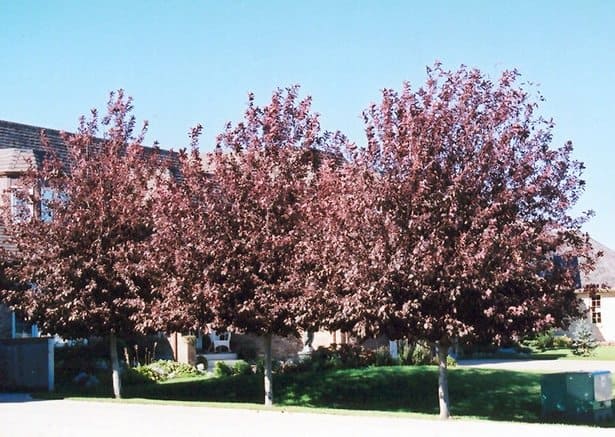
There are two weeping Higan cherry trees (Prunus subhirtella ‘Pendula’, Zone 6) on my road, and I wish they were mine! Nothing says spring like their pendulous branches loaded with ethereal pink flowers. These are grafted trees on six-foot (1.2-m) trunks; grafting keeps them at that height and allows for masses of slender, cascading branches. Sunlight shines through the pink petals, making the flowers appear incandescent. Their flowering period is short, but the effect is magical.
Fortunately, there are other flowering cherry trees on my road. The municipality has planted a few ‘Schubert’ chokecherries (Prunus virginiana ‘Schubert’, 16 x 16 ft / 5 x 5 m, Zone 3) as boulevard trees, and they’re interesting to watch develop from spring through summer. The generous flowers are three- to six-inch (8- to 15-)-long white racemes, appearing in late April or early May, and are followed by green foliage that slowly turns to reddish purple as temperatures increase. By midsummer this compact oval-shaped tree is fully purple, and takes on scarlet tones in autumn. The cherry-like fruits are edible (for jams, jellies, pies, sauces and wine), but you’ll have to compete with the birds for them. ‘Schubert’ chokecherry makes a good lawn specimen or anchor for one end of a long border.
As with all plum and cherry members of the Prunus genus, you have to inspect the branches in spring for evidence of black knot fungus (Apiosporina morbosa). You’ll know black knot fungus when you see it — round, elongated black swellings on slim twigs and branches, looking as if a thick black substance was dropped there and dried hard. Prune out the affected twig or branch back close to the main stem from which it originates. Shallow pruning doesn’t remove the undetectable developing site of spore infection on healthy wood behind the black swelling.
You might never see the fungus on a ‘Schubert’ chokecherry — which has some, but not complete, in-bred disease resistance — or you might find just one or two spots of it, which must be cut out. Occasionally, I see a wild plum or cherry tree growing unsupervised, and grossly covered in the black lesions, which can infect an entire neighbourhood of hybrid trees. If it’s on public property, I get after the municipality to do something about it. And you can be sure; I stay on the case until it’s done.









I’m thinking of making wine with the Schubert cherries on my tree. Would you recommend it?